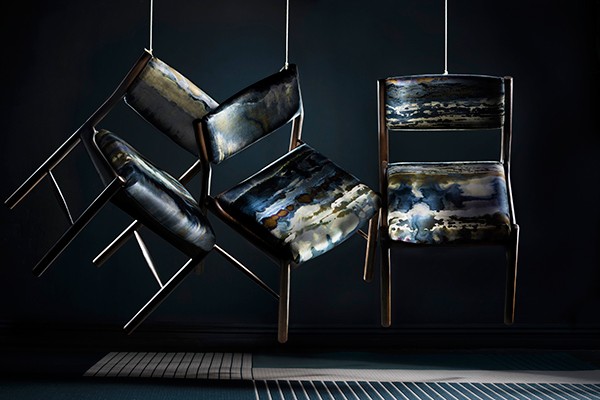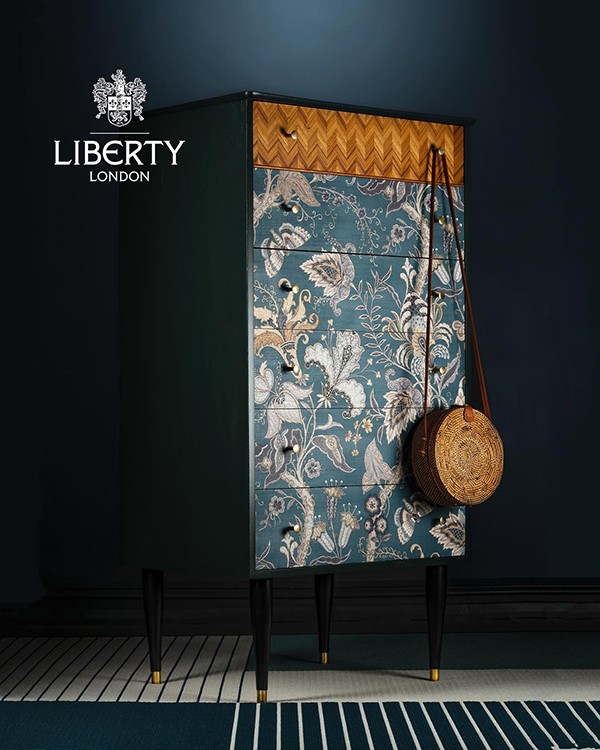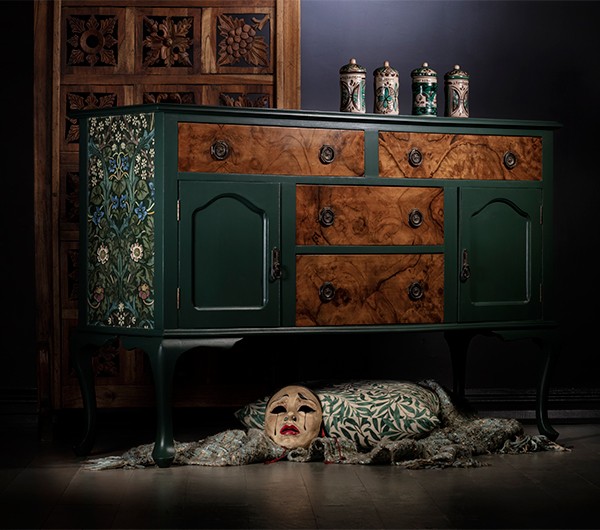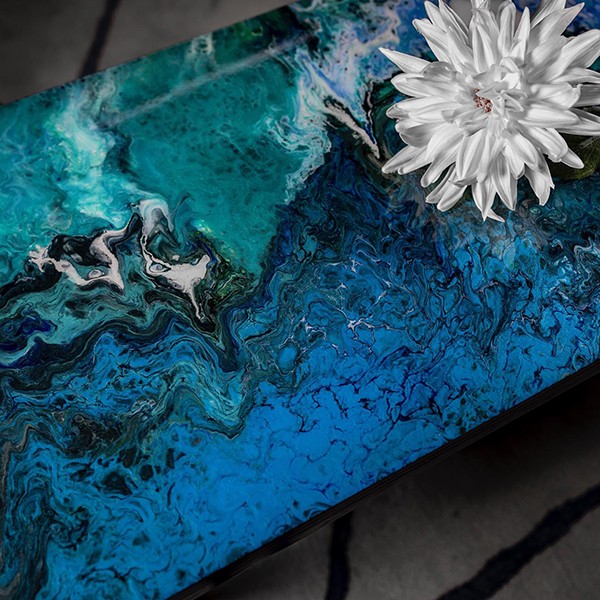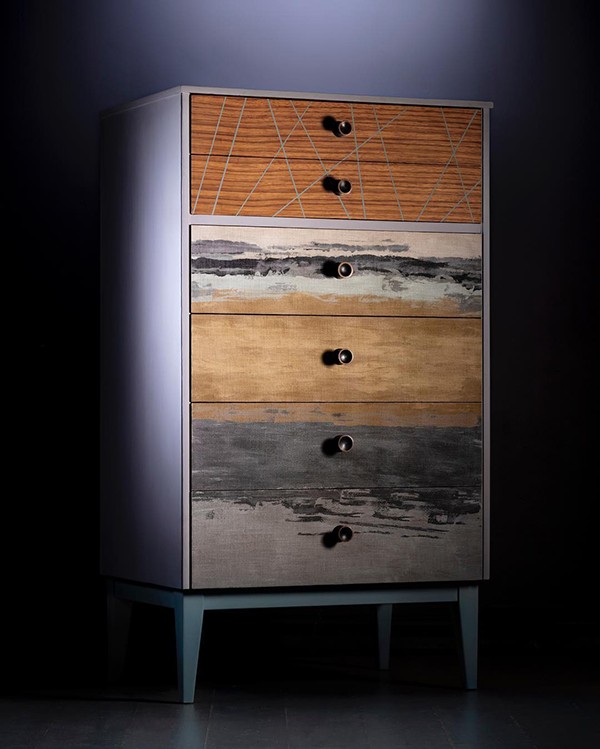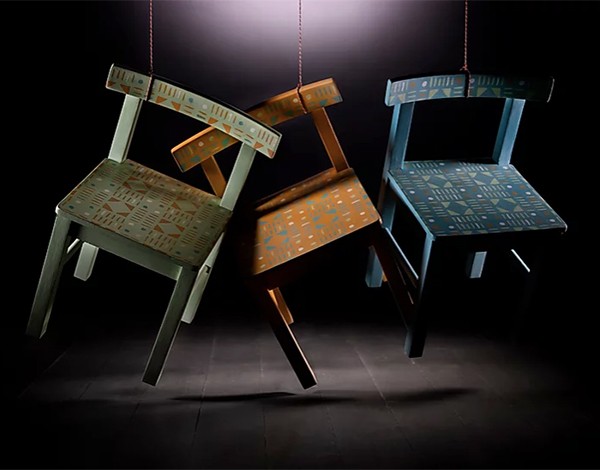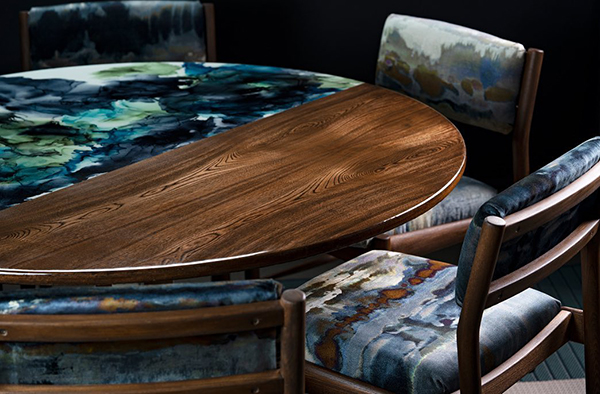Furniture experts Patience and Gough are a dynamic design duo, reviving found furniture in the stunning surroundings of Cumbria’s Lake District. Their upcycled furniture range was presented at London’s 100% Design exhibition last autumn. After being spotted by one of their buyers, several pieces were selected to go on sale at Liberty’s Regent Street store.
Hours of trial and error have gone into experimenting with different techniques, paints and tools, in order to perfect Patience & Gough’s signature formula. This includes the use of fabric coverings from designers such as William Morris and Clarke & Clarke and a technique consisting of acrylic paint and epoxy resin.
I spoke to Oliver Gough about shifting attitudes towards upcycled homeware and the success of their distinctive style.
What were you both doing before you started working with furniture?
The whole upcycling thing started with Alice. She had gone through a fine art degree, left feeling unfulfilled and was unsure about her direction. After doing work experience with an interior designer, she knew that she wanted a future that involved aspects of interior design.
The idea of refurbishing furniture first came to her when she was painting a computer desk her dad had built from back in the day and she decided to revamp it for her own room. She enjoyed it so much that she went on to find several more interesting pieces and work on them while researching and learning along the way.
From there she started a business called Down The Rabbit Hole Furniture. She worked under this name for around 5 years alongside a part-time job and mainly sold on Etsy.
I have a background in photography and graphic design. I came back from travelling around Australia and was working as a photographer when I met Alice. We quickly fell in love and eventually I got roped into the upcycling business.
Firstly it started with me photographing her work to put online, but after having a go with a brush, it developed into me creating my own furniture and us collaborating together. From there, I built a website and we rebranded as Patience & Gough. Patience being Alice’s middle name and Gough my last.
How has your brand evolved?
After building our own website, things really started to kick off. Branding is such an important aspect of a business and it goes a long way in creating an image and style that people want to be a part of. We built our own photography studio that we share with Alice’s brother and sister, who are also both photographers. It’s a great communal space and we share equipment and ideas alike.
We then progressed onto selling our furniture on Vinterior and other online platforms, shifting away from Etsy, which can often be an oversaturated market. Patience & Gough has continued to grow and we are now in our second year.
Do you each have different skills that you bring to each piece?
Yes, absolutely. We both have different styles and skills that we bring to each creation. Over the last 5 years, Alice has developed her technique of applying fabric to furniture and refined it, creating our own mixtures of products to adhere the fabric.
We have not come across any other furniture designer using fabric in the same way that we do. It allows us to incorporate designer patterns and textures around a room, tying in existing styles of interior design into the furniture we create.
Alice deals with all the fabric. I sand a lot. Which I don’t mind. Sanding can often be very therapeutic (with headphones in). I’m also good at ombre and hand-painting furniture or creating geometric designs with tape etc.
We consult each other for feedback and guidance, always settling on the end style together.
What techniques are you using to upcycle furniture?
Many different techniques and we are always learning and creating new ones. Fabric is our speciality but we employ a vast array of different paint styles to compliment the fabric we choose.
We recently started using acrylic pouring techniques and epoxy resin. One of our largest works to date was a 6 chair dining table with an epoxy covered top. Alcohol ink is another new one we have developed and again, we have not come across anyone using this on furniture.

Do you believe upcycled pieces should allow for further revamping in the future?
We started this business because we strongly believe in recycling. It’s one of the main aspects that drives us to do what we do. More and more the impact of environmental destruction is in the limelight. Mass-producing products simply won’t cut the mustard anymore and companies and brands are having to rethink the way they produce their products.
There is so much used or unwanted furniture already out there, often designed and built with far more love and care than furniture built today. Our aim is to reuse that furniture, adding our own style and bringing it back into the 21st century.
There is no reason why in the next 100 years, designers of the future might want to do the same to one of our pieces, and we would welcome that entirely.
Is your client base most interested in readymade pieces or commissioning furniture to fit an existing interior?
We have the ready to buy range of furniture that we create and sell through our website. These are one-off pieces but they are also there to show customers what we can achieve and what styles are possible.
We get a lot of commission work and that always comes first, so our turn around times are as short as possible. We work closely with clients, sourcing the furniture they want or working with existing pieces they bring to us.
Fabric is great because you can incorporate existing textiles into the furniture and tie a room together. Because of this, we sell throw cushions and lampshades that highlight the textiles we use in the piece. In between commissions, we work on our own ideas, so I guess it’s 50/50.
Tell us about your collaboration with Liberty
We took part in the 100% Design show 5 months ago. This gave us the opportunity to put our work out there in a professional environment, showcasing it to leading brands, interior designers and buyers. The feedback was fantastic. We had so much positivity towards our approach particularly the recycling aspect of our business.
The show was full of very modern high-end interior products. We were very different in our approach but I think people liked that. A buyer from Liberty London spotted us there and two weeks after the show we got an email asking for more information on our business.
We just sold our first piece in Liberty’s last week and they are replacing it with another, totalling 5 pieces so far. Having our furniture selected by Liberty is a huge step and we are proud that a shop with such prestige is willing to lead the way and push recycled furniture forward.
What inspires your approach to colour and pattern?
It all comes from the piece really and what materials we have to hand. Once you sand off the awful varnish from a lovely piece of vintage furniture, it’s a blank canvas. From there you make your decisions.
If it’s a traditional piece then we will use traditional fabric and colours, often highlighting the wood grain. If it’s modern, it allows us to be as creative as we want really.
Describe an average day in the studio
A piece usually takes around a week to finish. We can both work on one piece at the same time. We are looking at getting a larger workshop that would allow us to have a production line.
The first step is sanding which usually takes all day with a power sander and then by hand. After the paint and fabric, we are shooting the finished product in the photography studio by the end of the week.
We usually don’t get up too early but work late. Glasses of wine can come out past 5pm and we can often still be working at 11pm.
Which piece are you most proud of?
That’s a tough question. They are all personal and all signify a journey we went through and time we dedicated to achieving the finish. We are both proud of everything we produce.
The most impressive thing we have produced was the dining set I mentioned before. The 6 chairs took Alice a month to sand and reupholster and the table took me many many man-hours of sanding and polishing the alcohol ink epoxy finish. It sold to an advertising company down in London, who ironically advertise for IKEA – haha!
How do you ensure a high quality finish?
Practice. The hardest part of doing what we do is finding products we are happy to use on our furniture. Paint can be so temperamental, we have tried so many different brands, brushes, rollers etc. Over the years we have narrowed it down to the few that we still use today, but it’s been a long journey.
A few years ago upcycling was looked down on, mainly having the stereotype of shabby chic, amateur pieces. Now the whole upcycling world has changed. Talented designers and artists are seeing furniture as the new canvas for their work, breeding interesting and innovative designs. It’s on TV, it’s on the high street, flooding Instagram and the web.
Now, having a bespoke, artisanal piece of furniture in your home holds more value than an expensive white box with no character. We are proud to be at the forefront of this change of ideas and shift of opinion.
❈
Check out additional interviews with talented furniture upcyclers Daniel Heath and Jo Gibbs

